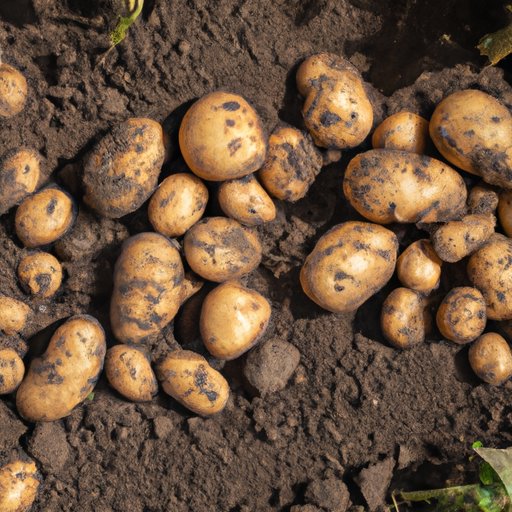
I. Introduction
Potatoes are a staple crop that is consumed worldwide in various forms. However, a common problem for those growing potatoes is not knowing when they’re ready for harvesting. It may be hard to detect when it’s time to harvest these subterranean vegetables, but it’s crucial to get it right. This article serves as a comprehensive guide for growers to know when a potato is ready for harvest. It’s intended for home gardeners and small-scale farmers.
II. Guide to Growing and Harvesting Potatoes: Knowing When They’re Ready
The process of growing and harvesting potatoes involves preparing the soil, planting the seeds or “seed potatoes,” providing the required nutrients for growth, and monitoring the plant as it develops. Potatoes require a minimum of 70-120 days to mature from the planting time. However, it’s essential to know when the potato plant has reached its maturity to harvest it effectively.
III. Signs that Your Potato Plant is Ready for Harvesting
To know when it’s time to harvest potatoes, growers watch for the physical indications of maturity on the plant. These signs include yellowing foliage, the drying up of stems, and the wilting of leaves. These are indications that the plant has completed their lifecycle, and the plant no longer receives nutrients from its leaves. The potato seedlings will then send those nutrients to the tubers to mature and increase in size.
Proper inspection of the plant can help determine whether the potatoes are ready. The growers may dig up a plant or two to see if they are matured. This initial inspection will give the growers a reasonable indication of their harvest readiness.
IV. Tips for Harvesting Potatoes at the Right Time
The timing for harvesting potatoes is critical. Harvesting too early may result in missing out on potatoes that are more significant and fully matured, while harvesting too late may result in rotted or ruined tubers. The ideal time to harvest potatoes is during the fall season as the leaves are starting to turn yellow or brown, between 14 to 20 days after the foliage has withered.
The type of potato being grown also determines when to harvest potatoes. Early-season potatoes mature much quicker than late-season potatoes. Growers should keep an eye on the weather forecast. Wet and humid conditions can increase the risk of early rotting or bacterial issues, and dry spells can lead to hard, discoloration, and scabby potatoes. It’s crucial to remember that timing is critical when harvesting potatoes, and growers need to adjust accordingly.
V. How to Determine if Your Potatoes Are Ready for Harvest
The best way to determine if your potatoes are ready for harvest is to lift the plants carefully from the soil and examine the potatoes themselves. If the potato is mature, it should be a decent size, and the skin should be reasonably firm. The skin’s texture should be tough enough to withstand light pressure without breaking or flaking off.
Tubers are mature when there is proper “tube development.” Tubes are small buds on the potato’s skin that grow perpendicular to the seed’s growth. If there are no tubes on the skin, the potato still has some time to mature. If the tubes are too long, this could indicate that the potato is overmatured and might not be suitable for cooking. Additionally, check the condition of the foliage, especially for the earliness of the potatoes. Healthy leaves indicate that the potatoes are ready for harvest, while withered foliage indicates that the potatoes have started to mature or are overmatured.
VI. A Comprehensive Guide on How to Harvest Potatoes: Timing and Techniques
To harvest potatoes, you will need a digging fork or a shovel to gently pry the plant from the soil, making sure not to damage the tubers. Once the plant is out of the soil, remove the potatoes from the plant, brushing off any excess dirt, and place them in a container or bucket. The best way to handle them is to dig around the potato plant gently so as not to harm the tubers, which are delicate. Make sure to dry the potatoes off before storing them.
It’s essential to cure recently harvested potatoes to strengthen their skins, make them last longer, and improve their flavors. Drying and curing involve leaving the potatoes in a dark, well-ventilated spot for about ten days. After the curing period, store your potatoes in a cool, dry, and dark place for the best results. Make sure to keep them away from light as this can cause them to spoil.
VII. Farm to Table: How to Tell When Your Potatoes are Ready for Harvesting
Once harvested, potatoes can be used in various dishes such as baked potatoes, mashed potatoes, French fries, potato soup, and more. Homegrown potatoes are healthier and tastier than store-bought ones since they do not contain as many preservatives and pesticides. Clean your potatoes thoroughly before cooking or storing them.
VIII. Conclusion
Timing is essential when it comes to harvesting potatoes. Growers need to know when it’s the right time to avoid missing out on fully matured potatoes or ending up with rotten ones. By following the guide, gardeners and small farmers alike can determine the right time to harvest their potatoes successfully. With the right timing, techniques, and storage, they can enjoy farm-to-table potatoes in their dishes, adding an appealing and healthy touch of flavor to their meals.





